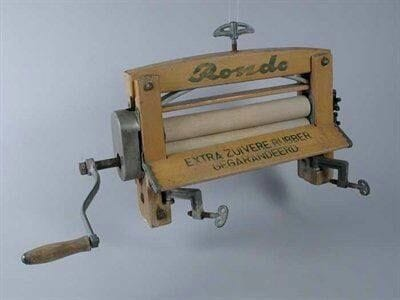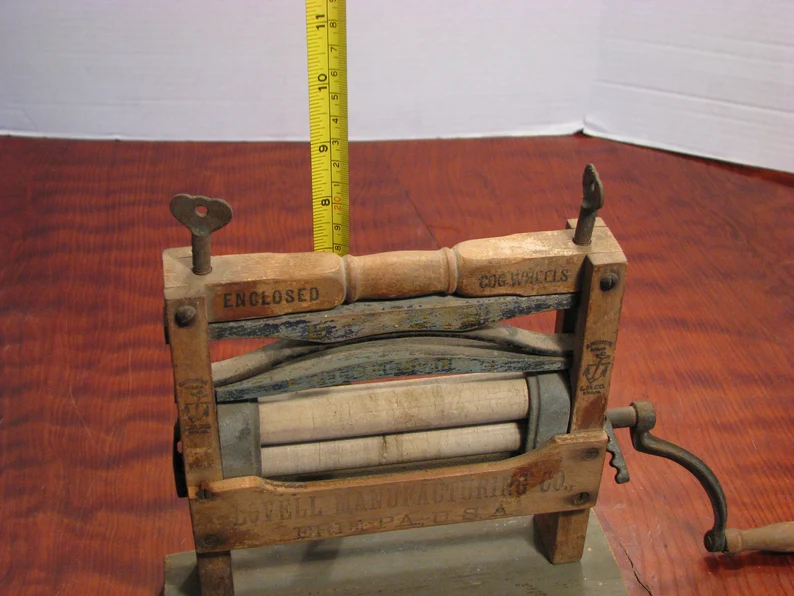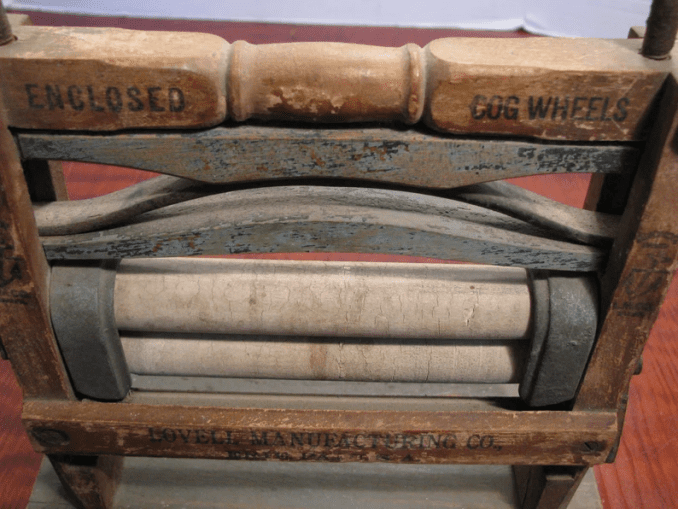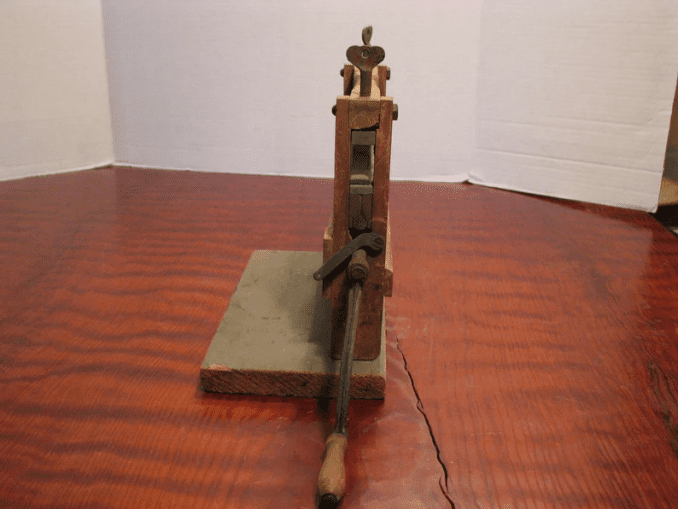Take a closer look at this wooden contraption, and you might feel a pang of nostalgia. This is the Anchor Brand Bicycle Clothes Wringer, a staple of 19th and early 20th-century households. Before the convenience of modern washing machines and dryers, this device was a groundbreaking invention, streamlining the labor-intensive task of laundry.
At its core, this tool was designed to wring excess water from freshly washed clothes, making the drying process faster and more efficient. Its clever hand-crank mechanism and bicycle-inspired design made it a beloved household aid, saving time and effort for families of the era.
How Did the Clothes Wringer Work?

The Anchor Brand Bicycle Clothes Wringer operated on a simple yet effective principle: pressing water out of wet clothes using two rollers. Here’s how it worked:
- Insert Clothes: After washing, wet clothes were fed between two sturdy rollers made of wood or rubber.
- Turn the Crank: A hand-crank mechanism, designed with gears similar to those on a bicycle, turned the rollers.
- Remove Water: As the rollers pressed together, they squeezed water out of the fabric, leaving the clothes much drier and ready for hanging.
The device’s simplicity was its genius. It required no electricity, and its durable construction meant it could withstand heavy use over the years. Though it demanded some manual effort, it was far easier than wringing clothes by hand.
The History of the Anchor Brand Wringer
Manufactured during the late 19th and early 20th centuries, the Anchor Brand Bicycle Clothes Wringer was a product of its time—a period of rapid industrial innovation. It was produced by companies like the Lovell Manufacturing Company in Erie, Pennsylvania, which became synonymous with quality laundry tools.
The name “Bicycle” came from its gear-like design, which resembled the mechanics of early bicycles. This unique engineering not only improved efficiency but also gave the wringer a sleek, modern aesthetic that appealed to families seeking practical yet stylish tools for their homes.
Laundry in the Past: A Grueling Chore Made Easier
In the days before electric washers, laundry was a physically demanding task that consumed an entire day. The process involved several labor-intensive steps:
- Soaking and Scrubbing: Clothes were washed by hand in large tubs of soapy water or scrubbed on a washboard—a process that required significant elbow grease.
- Rinsing: Soapy clothes were rinsed in clean water, often multiple times, to remove all detergent residue.
- Wringing: This is where the clothes wringer shined. It made removing water faster and less strenuous than hand-wringing.
- Drying: Clothes were then hung outside on lines to dry in the sun or near a fire on rainy days.
The Anchor Brand Bicycle Clothes Wringer transformed this routine. By eliminating the need to hand-wring clothes, it saved time and effort, particularly for women, who typically shouldered the burden of household chores. Its role in easing the workload of laundry day cannot be overstated.
Why Was It Called the “Bicycle” Wringer?

The “Bicycle” name wasn’t just a marketing gimmick—it described the innovative design that set this wringer apart. The hand-crank mechanism operated similarly to the gears and chains of a bicycle, allowing for smoother operation and reduced strain on the user. This clever engineering was ahead of its time, blending practicality with a touch of modern flair.
Additionally, the design gave the wringer an aesthetic appeal. Its polished wood, sturdy cast iron, and sleek mechanics made it not only functional but also a stylish addition to any home.
A Symbol of Domestic Innovation
The Anchor Brand Bicycle Clothes Wringer wasn’t just a tool; it was a symbol of progress and ingenuity. During the late 19th century, industrial advances aimed to make life easier for everyday people, and this wringer was a perfect example. It embodied the era’s emphasis on practicality and efficiency, providing an affordable, durable solution to a universal household challenge.
The device also reflected the changing role of women in domestic life. While laundry remained a labor-intensive chore, tools like the wringer offered a small but significant reprieve, empowering women to manage their time more effectively.
The Decline and Resurgence of the Clothes Wringer

As electric washing machines with spin cycles became more common in the mid-20th century, hand-crank clothes wringers gradually fell out of use. By the 1950s, they were largely considered obsolete, replaced by modern appliances that required less manual effort.
However, the Anchor Brand Bicycle Clothes Wringer has enjoyed a resurgence in recent years, thanks to its vintage charm and historical significance. Today, it’s highly prized by collectors and antique enthusiasts. Many people display these wringers as decorative pieces in their homes, celebrating their craftsmanship and connection to a bygone era.
Why These Vintage Wringers Still Matter
Even in a world dominated by high-tech appliances, the Anchor Brand Bicycle Clothes Wringer remains relevant for several reasons:
- Durability: These devices were built to last, often surviving decades of heavy use. Their longevity is a testament to the quality of their construction.
- Sustainability: In an age of disposable goods, the wringer’s reusability and repairability are inspiring examples of eco-friendly design.
- Nostalgia: For those who remember using one or hearing stories about them, the wringer evokes a sense of nostalgia and a connection to simpler times.
- Cultural Significance: As a symbol of domestic life in the late 19th and early 20th centuries, the wringer offers a tangible link to history.
Caring for Your Anchor Brand Bicycle Clothes Wringer

If you’re lucky enough to own one of these vintage treasures, proper care can help preserve its functionality and charm:
- Clean Regularly: Use a soft cloth and mild cleaner to remove dust and grime from the wood and metal parts.
- Protect Against Moisture: Store the wringer in a dry place to prevent rust and wood damage.
- Use Sparingly: If the rollers are intact, you can still use the wringer for light tasks or crafting projects, but avoid overuse to preserve its condition.
A Lasting Legacy of Ingenuity
The Anchor Brand Bicycle Clothes Wringer is more than a household tool—it’s a piece of history. It tells the story of a time when innovation was driven by necessity, and tools were built to endure. For those who remember using one, it’s a cherished memory of a bygone era. For younger generations, it’s a fascinating glimpse into the daily lives of their ancestors.
Whether displayed as a collector’s item or remembered as a functional staple of the past, the Anchor Brand Bicycle Clothes Wringer continues to captivate and inspire. Its legacy reminds us of the ingenuity, resilience, and practicality that shaped the way we live today.


